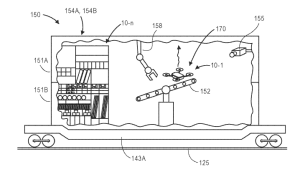In this picture taken on November 6, 2020, an employee works in the warehouse of Cainiao Smart Logistics Network, the logistics affiliate of e-commerce giant Alibaba, in Wuxi, China’s eastern Jiangsu province, ahead of Singles’ Day, also known as the Double 11 shopping festival – the world’s biggest shopping event – which falls on November 11. Photo by HECTOR RETAMAL/AFP via Getty Images
It might not be the slickest thing on four wheels, and it definitely won’t win any time trials, but Chinese logistics firm Cainiao’s new Xiao G delivery cart could be the future.
Every hour, the three-foot by five-foot automated vehicle picks up packages from Cainiao’s depot in Hangzhou—a city of 10 million people in China’s booming east—and tours a nearby neighborhood. Locals in pajamas pop down to meet the driverless cart at their nearest delivery point and type in a reference number. A door in the vehicle’s side pops open and the customer’s parcel can be retrieved. Xiao G heads onto the next stop, weaving ponderously through traffic via 360-degree sensors.
“It sends a message to customers after setting off and another when it arrives at a pick-up point so they know to come down,” says Cainiao engineer Long Fei. “Some models allow customers to drop off as well as pick up packages.”
In terms of innovations in logistics, Xiao G may not be as earth-shaking as the shipping container or the cargo jet. But it is the most visible aspect of a stealthy revolution powered by Cainiao, which was founded in 2014 and whose name means “rookie” in Chinese. The $10 billion subsidiary of e-commerce behemoth Alibaba says it is poised to transform worldwide trade.
How your purchases could be delivered in the future
The Xiao G is part of Cainiao’s plan to create a single ecosystem for all logistics firms across the world to plug into, allowing for the seamless transfer of goods between companies and jurisdictions. Just as myriad smartphone makers all operate on Google’s Android, Cainiao envisages thousands of independent logistics firms can operate within its system, sharing everything from labeling standards to customs information.
“What they’re doing is bigger than it appears to be,” says Jeffrey Towson, a private-equity investor and a professor of investment at Peking University in Beijing. “It might be the single most important thing happening in China’s digital space.”
Cainiao is far from a typical logistics firm, but is an open platform that allows for collaboration with 3,000 logistics partners and 3 million couriers—including the top 15 delivery firms inside China and 100 operating internationally. This enables merchants to choose the most cost- and time-efficient delivery option, based upon real-time data crunching of optimum firms and routes.
For consumers and manufacturers, this means a typical, 1 kg package can be sent anywhere in China within 24 hours for around 30 cents. The goal is to deliver it anywhere in the world within 72 hours for $3. (Currently, a DHL envelope under 0.5 kg from Shanghai to London costs around $100 and takes typically 5 days.) That stands to be a life-changing boon to coffee-growers in Peru, textile-weavers in Chad, medical instrument producers in Bangalore and everyone in between.
How the COVID-19 pandemic pushed logistics innovation
By putting sensors in everything—along with cameras in every warehouse and GPS on every truck and package—Cainiao aims to digitize the logistics process from top to bottom.
In China, the implications are vast for the $1.94 trillion e-commerce sector, currently the world’s largest and three times the size of its U.S. counterpart. Some 64 billion parcels were sent last year domestically but current delivery networks are piecemeal, inefficient and wasteful. Wander any Chinese city or town and it’s common to see gangs of smoking delivery drivers sorting through heaps of crumpled packages on the street. Packaging is also obscenely wasteful: order a 0.1mm protective film for your smartphone screen and you could find it turning up in a shoebox-sized carton packed with air pillows and styrofoam.
So there’s enormous scope to boost profits, and safeguard the environment, though savings on fuel, packaging and unnecessary storage. E-shipping labels alone save over 400 billion pieces of paper and offset a billion kilograms of carbon emissions annually, according to Cainiao. And then there is the cost. “China will process 70 billion parcels this year,” says Wan. “What if you can shave just one cent off each one?”
Wan is used to thinking big. After earning a doctorate at the University of Texas at Austin, he spent nine years at Amazon, eventually reporting directly to Jeff Bezos as director of global logistics strategy. He says Seattle “still feels like home” and credits Bezos for instilling an ethos of “let’s raise the bar and exceed expectations.”
Read more at China’s Cainiao Is Revolutionizing How Goods Get Delivered. Will the Rest of the World Follow Its Rules?
What do you think about this topic? Share your opinions with us in the comment box below, and subscribe us to get updates.





































